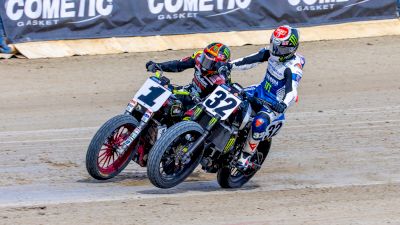The Future Of Motocross May Well Include E-Bikes, But The Future Is Not Now
The Future Of Motocross May Well Include E-Bikes, But The Future Is Not Now
E-bikes may be the future of Motocross. but that futures is still some time away.

E-bikes are an expensive, quickly evolving technology from which the industry can profit. And this is starting to seem reminiscent of when two strokes were killed off by four strokes.
That, funnily enough, is probably the biggest danger electric bikes like the Alta Redshift pose to the sport of motocross. If the inclusion of e-bikes in racing is not handled with delicate care, it could spell the end of significantly cheaper combustion bikes and result in a further decline of bike sales and rider participation.
For years, motocrossers have heard that electric bikes are the future. Most riders know intuitively that it's true, due to the very nature of racing. Every racer who has been around for more than a few months has their own story of an angry neighborhood association taking out the friendly local motocross track. Typically, the main complaint cited is the supposed noise nuisance.
To racers, the sound of a powerful motor is as pleasant as listening to a Mozart symphony. Hearing the roar of 40 bikes on the starting line fills them with joy, excitement, and the racing spirit. But it is rare that the new housing development next door shares that opinion.
Electric motors are supposed to be the solution but are often met with mixed feelings from riders. The smell of race fuel and exhaust, the sound of a high-revving engine, the vibration of a powerful 450 -- these are all huge sensory components to the allure of racing.

Bike reviewers and magazine writers often celebrate the electric bikes unilaterally, praising the manufacturers for their torque, and curiously omitting any remotely negative points. For a group of people that can find the faults in a factory bike, this is a particularly suspicious phenomenon.
No doubt the reviewers have the best interest of the sport at heart when they talk up the e-bike, but it is potentially a short-sighted measure. When people ride the bike for themselves or buy one for themselves, they will overcome the thrill of instant torque, begin to notice the flaws, and might be turned off by the machines altogether. A healthy dose of reality would be wise to include with the electric bikes.
Let's start with the main problem: An e-bike cannot finish a moto right now. At best a pro rider might be able to finish a supercross race, but that's no guarantee. And that's with a bike that is an additional 20 to 40 pounds heavier than the competition, depending on how close they want to cut it with the battery life.
Battery capacity is the main limiting factor for electric vehicles as a general rule, from the Tesla to the Alta. Lithium-ion batteries have opened up a massive door for electric vehicles, as their energy-to-weight ratio is drastically better than old lead-acid batteries. And with modern production techniques, they are becoming relatively affordable and pretty much ubiquitous for anything battery-powered in the modern world.
But could they last a 35-minute moto at pro-level power output? Unfortunately, the technology is not there yet. Without having a bike that weighs as much as a MotoGP machine, it just isn't going to happen until some substantial progress is made.
That might sound like a pretty small feat, as progress is made daily in the fast-paced, hi-tech world of today. But batteries are really pushing the limits of our ability to improve on them, and it's not likely that they'll be able to squeeze twice as much energy into a LiPo without making enormous sacrifice on safety, reliability, and, of course, cost.
Safety is a huge issue for a sport like motocross. Motocross bikes take a beating that no other racing machine in the world can handle. Even rally cars and trophy trucks would crumple up into a ball if you tried to hit a 70-foot triple and a set of fourth-gear stadium whoops. Rarely can a MotoGP rider remount his bike after cartwheeling it down the track, but that's a regular occurrence at the motocross park.
Racers are often baffled at how certain parts are broken during the course of a race. Physics-defying rocks can crack what were supposed to be solid metal components. It's really impossible to know if a new part is capable of lasting through moto after moto of rigorous abuse, unless it has actually been through those real-world stressors.
And that's not to mention what happens to a bike during a crash. Experienced racers have all seen crashes result in broken subframes, punctured engine cases, flattened exhaust pipes, cracked frames, and everything else under the sun.

Needless to say, it would be a very unfortunate outcome if a lithium battery pack was punctured on a $15,000 motorcycle. Aside from the risk of becoming engulfed in the flames emanating from between the legs, the fire would be almost impossible to put out, and if the other cells caught on fire it would mean the end of that fancy machine at best.
Even if a bike didn't succumb to fire, there are other glaring issues with electric bikes. First, servicing a battery pack or motor is going to be impossible. There is no chance that a manufacturer will open themselves up to that liability, if it's even possible to fix. Which means, the only alternative is to purchase an extraordinarily expensive additional battery pack to swap out. In fact, if racing is the goal for an electric motocrosser, at least one or two additional batteries would likely be requisite to keep on hand.
There is little information on what the battery costs, but considering it is a proprietary, high-capacity battery with cutting edge technology involved, one may assume it is probably very expensive. Somewhere in the realm of $4,000-5,000 would not be surprising for a retail price.
With lithium-ion batteries, there are a number of factors that can affect the lifespan and health of a battery. Vehicles like the Alta will have computer protection systems in place to manage the battery, but as with any electronic system it can fail. Batteries are to be kept at 50 percent when in storage to maximize their lifespan, not held at 100 percent for very long, and never discharged to zero percent (or even close to it). Even under perfect care, given the rigors of motocross, batteries will probably need replacement relatively often.
It is easy to get swept up in the excitement of e-bikes, with charismatic brands like Tesla and Alta working the media up into a frenzy. But the sanctioning bodies involved in motocross need to keep a level head and not make decisions that will adversely affect the participants of the sport.
E-bikes are great, but let's not get carried away.
That, funnily enough, is probably the biggest danger electric bikes like the Alta Redshift pose to the sport of motocross. If the inclusion of e-bikes in racing is not handled with delicate care, it could spell the end of significantly cheaper combustion bikes and result in a further decline of bike sales and rider participation.
For years, motocrossers have heard that electric bikes are the future. Most riders know intuitively that it's true, due to the very nature of racing. Every racer who has been around for more than a few months has their own story of an angry neighborhood association taking out the friendly local motocross track. Typically, the main complaint cited is the supposed noise nuisance.
To racers, the sound of a powerful motor is as pleasant as listening to a Mozart symphony. Hearing the roar of 40 bikes on the starting line fills them with joy, excitement, and the racing spirit. But it is rare that the new housing development next door shares that opinion.
Electric motors are supposed to be the solution but are often met with mixed feelings from riders. The smell of race fuel and exhaust, the sound of a high-revving engine, the vibration of a powerful 450 -- these are all huge sensory components to the allure of racing.

Bike reviewers and magazine writers often celebrate the electric bikes unilaterally, praising the manufacturers for their torque, and curiously omitting any remotely negative points. For a group of people that can find the faults in a factory bike, this is a particularly suspicious phenomenon.
No doubt the reviewers have the best interest of the sport at heart when they talk up the e-bike, but it is potentially a short-sighted measure. When people ride the bike for themselves or buy one for themselves, they will overcome the thrill of instant torque, begin to notice the flaws, and might be turned off by the machines altogether. A healthy dose of reality would be wise to include with the electric bikes.
Let's start with the main problem: An e-bike cannot finish a moto right now. At best a pro rider might be able to finish a supercross race, but that's no guarantee. And that's with a bike that is an additional 20 to 40 pounds heavier than the competition, depending on how close they want to cut it with the battery life.
Battery capacity is the main limiting factor for electric vehicles as a general rule, from the Tesla to the Alta. Lithium-ion batteries have opened up a massive door for electric vehicles, as their energy-to-weight ratio is drastically better than old lead-acid batteries. And with modern production techniques, they are becoming relatively affordable and pretty much ubiquitous for anything battery-powered in the modern world.
But could they last a 35-minute moto at pro-level power output? Unfortunately, the technology is not there yet. Without having a bike that weighs as much as a MotoGP machine, it just isn't going to happen until some substantial progress is made.
That might sound like a pretty small feat, as progress is made daily in the fast-paced, hi-tech world of today. But batteries are really pushing the limits of our ability to improve on them, and it's not likely that they'll be able to squeeze twice as much energy into a LiPo without making enormous sacrifice on safety, reliability, and, of course, cost.
Safety is a huge issue for a sport like motocross. Motocross bikes take a beating that no other racing machine in the world can handle. Even rally cars and trophy trucks would crumple up into a ball if you tried to hit a 70-foot triple and a set of fourth-gear stadium whoops. Rarely can a MotoGP rider remount his bike after cartwheeling it down the track, but that's a regular occurrence at the motocross park.
Racers are often baffled at how certain parts are broken during the course of a race. Physics-defying rocks can crack what were supposed to be solid metal components. It's really impossible to know if a new part is capable of lasting through moto after moto of rigorous abuse, unless it has actually been through those real-world stressors.
And that's not to mention what happens to a bike during a crash. Experienced racers have all seen crashes result in broken subframes, punctured engine cases, flattened exhaust pipes, cracked frames, and everything else under the sun.

Needless to say, it would be a very unfortunate outcome if a lithium battery pack was punctured on a $15,000 motorcycle. Aside from the risk of becoming engulfed in the flames emanating from between the legs, the fire would be almost impossible to put out, and if the other cells caught on fire it would mean the end of that fancy machine at best.
Even if a bike didn't succumb to fire, there are other glaring issues with electric bikes. First, servicing a battery pack or motor is going to be impossible. There is no chance that a manufacturer will open themselves up to that liability, if it's even possible to fix. Which means, the only alternative is to purchase an extraordinarily expensive additional battery pack to swap out. In fact, if racing is the goal for an electric motocrosser, at least one or two additional batteries would likely be requisite to keep on hand.
There is little information on what the battery costs, but considering it is a proprietary, high-capacity battery with cutting edge technology involved, one may assume it is probably very expensive. Somewhere in the realm of $4,000-5,000 would not be surprising for a retail price.
With lithium-ion batteries, there are a number of factors that can affect the lifespan and health of a battery. Vehicles like the Alta will have computer protection systems in place to manage the battery, but as with any electronic system it can fail. Batteries are to be kept at 50 percent when in storage to maximize their lifespan, not held at 100 percent for very long, and never discharged to zero percent (or even close to it). Even under perfect care, given the rigors of motocross, batteries will probably need replacement relatively often.
It is easy to get swept up in the excitement of e-bikes, with charismatic brands like Tesla and Alta working the media up into a frenzy. But the sanctioning bodies involved in motocross need to keep a level head and not make decisions that will adversely affect the participants of the sport.
E-bikes are great, but let's not get carried away.
Related Content
 Flashback: 2022 American Flat Track Super Twins at Texas Half-Mile
Flashback: 2022 American Flat Track Super Twins at Texas Half-MileApr 23, 2024
 Hype Video: American Flat Track Heads To Texas Motor Speedway
Hype Video: American Flat Track Heads To Texas Motor SpeedwayApr 23, 2024
 American Flat Track Stars To Shine Bright At Mission Texas Half-Mile
American Flat Track Stars To Shine Bright At Mission Texas Half-MileApr 23, 2024
 American Flat Track Results: Yamaha Senoia Short Track
American Flat Track Results: Yamaha Senoia Short TrackMar 25, 2024
 Highlights | 2024 American Flat Track at Senoia Raceway
Highlights | 2024 American Flat Track at Senoia RacewayMar 24, 2024
 SuperTwins Main | 2024 American Flat Track at Senoia Raceway
SuperTwins Main | 2024 American Flat Track at Senoia RacewayMar 24, 2024
 AFT Singles Main | 2024 American Flat Track at Senoia Raceway
AFT Singles Main | 2024 American Flat Track at Senoia RacewayMar 24, 2024
 American Flat Track Yamaha Senoia Short Track: How To Watch & What To Watch
American Flat Track Yamaha Senoia Short Track: How To Watch & What To WatchMar 21, 2024
 Full Replay | 2023 American Flat Track Yamaha Senoia Short Track
Full Replay | 2023 American Flat Track Yamaha Senoia Short TrackMar 19, 2024